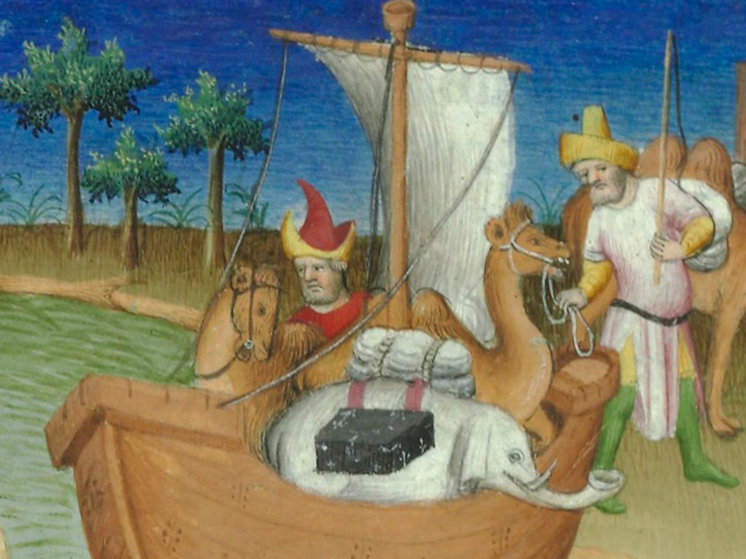The true story of a 14th century bestseller
Marco Polo's miracle-filled tales are the first European account of the Silk Road. In them, the traveler claimed to have seen a unicorn on the Indonesian island of Sumatra. Is it true? Valuable questions have questioned the veracity of Marco Polo since the 14th century, when his book The Travels of Marco Polo became a bestseller and was translated into dozens of languages, copied in countless manuscripts and available at every luxurious court in Europe.

The stories of Marco Polo are the first European account of the Silk Road, but “they are hard to believe.” 700 years after Polo's death in 1324, scientists can confidently confirm that the famous Venetian merchant, explorer, writer and self-taught anthropologist actually saw a unicorn, or at least that he did not lie about it.
According to the merchant's text, during his three-year journey along the Great Silk Road — from Acre (in modern Israel) to the court of the Mongol emperor Kublai Khan in Khanbalik (modern Beijing) — he and his companions crossed the Middle East and much of Central Asia. They then spent about 20 years in China, doing business and serving as ambassadors of sorts for the local government. They returned via Sumatra and the Andaman Islands, sailing around India before reaching Aden, Istanbul and finally Venice.
When they reached home, Polo was over 40. According to legend, when they knocked on the door of their palazzo, a servant asked who was there, and they answered in the local dialect «masters.»
Meeting in prison with the writer inspired Polo to create his stories. The book became a “hit” of its time. Over the centuries, this has become a complete mystery to philologists, as the original version was soon lost and what remains are dozens of translations, none of which are necessarily accurate.
Marco Polo specialist Eugenio Burgio explains that “the unconscious dream of a philologist is to become something like Indiana Jones, digging up treasures.” His team is doing just that: unearthing a literary gem written by one of the world's first travel writers.
Not only is the original version of his book lost forever, but the Polo family palace burned down in a fire in 16 century. Polo's tombstone in the Venetian church of San Lorenzo also disappeared, and not a single monument in the city was ever dedicated to him.
“It’s a curse,” says professor Tiziana Plebani, who spent 10 years studying Polo and his will, written on his deathbed. The veracity of the merchant's stories has been questioned for centuries. Did he really go all the way to China, and if that's true, why didn't he mention tea or the Great Wall of China? He didn't even speak Chinese, which seems unlikely for a man who claimed to have been doing business in the region for a quarter of a century.
Lately, experts seem to agree that there are reasonable answers. For example, Burgio is not shocked that Marco did not mention tea in his travelogue.
“Anglo-Saxon historians were fixated on tea drinking,” Burgio points out. “Why would Marco like tea? I understand if it was wine or coffee, but tea? Chinese at that time was not the language of the ruling class. And the Great Wall of China was not finished yet.”
However, Polo's interests and curiosity were multifaceted — «from the sexual habits of concubines to a special type of chicken that has fur instead of feathers.» Not only did he not believe that his own culture was superior to others, but he was also an ardent admirer of the Mongol Empire and wrote about the wonders and clever aspects of every culture he encountered.
“It was the first time Polo had traveled outside of Venice,” explains historian Zorzi. “It’s a beautiful open world, seen through the eyes of a teenager, and everything is so new, so incredibly interesting that he could capture it all in his head.” Today the world is a much smaller place, Burgio added, because there are few unexplored corners left.
“Polo teaches us to be open, more curious, more ready to interact with other cultures,” admits Professor Plebani, calling it “ a messenger of peace and wonder.”
What about the mythical animals he claims to have encountered? One of these is the medieval salamander, a legendary lizard that was believed to have the supernatural ability to live in fire. Polo confirmed that he had seen it in Northern China, but he also said that it was not an animal at all. He described it as a fire-resistant material that has threads.
Polo's unicorn had a black horn. He explained that its head is similar to the head of a wild boar and is always facing down.
“It is very ugly and does not look at all like what we imagine, it’s the other way around,” he described the animal. In fact, Polo saw what we now call a rhinoceros.























































Свежие комментарии